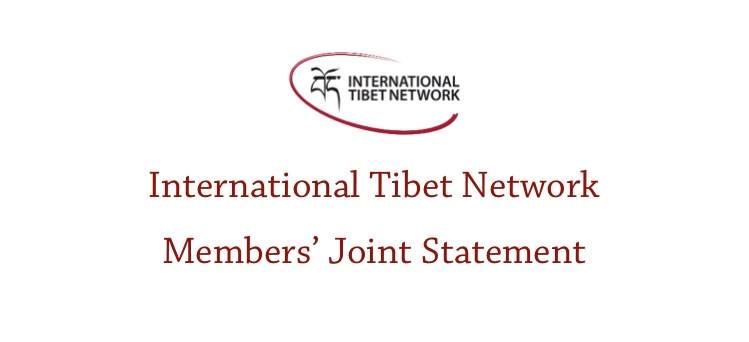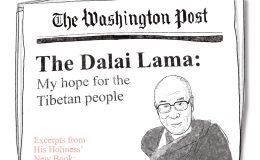For Immediate Release
30 October, 2012
Global Tibet movement expresses grief, demands world governments urgently form Contact Group as Tibetan self-immolations dramatically escalate on eve of China’s leadership handover.
Tibet campaigners issue challenge to Xi Jinping and 5th generation of Communist Party Leaders: end 60 years of policy failures or face growing resistance.
The 185 Tibet advocacy organizations that form the International Tibet Network (1) express their collective concern at the dramatic escalation in self-immolations in Tibet, with at least seven in the last week, bringing the total to 62 since 2009; no more than 10 protesters are thought to have survived (2). Network Members condemn China’s failed policies and ongoing crackdown in Tibet that are directly responsible for this wave of self-immolations protests, in which the majority of individuals have demanded freedom for Tibet and the return of the Dalai Lama. Campaigners warn that Tibetan non-violent resistance is likely to intensify with China’s once-a-decade leadership transition unless there are radical policy changes, and urgently call on world governments to establish a Contact Group on Tibet and begin to formulate new diplomatic strategies designed to address the crisis situation in Tibet (3).
“Tibetans have been challenging China’s occupation of Tibet for more than 60 years, and the self-immolations clearly show the urgent need for an end to Chinese rule”, said Tenzin Jigme of the International Tibet Network. “In a matter of days Xi Jinping and the Chinese Communist Party’s 5th generation leaders will inherit extraordinary powers and major challenges, not least of which is China’s continued efforts to control Tibet. We challenge Xi Jinping to acknowledge 60 years of policy failures and to seek a just solution to Tibetans’ unquenchable desire for freedom.” (4)
In the last week an unprecedented 7 Tibetans set light to themselves, four in just two days. On 25 October two young cousins shouted slogans and set light to themselves in their village north of Lhasa, in Nagchu county Central Tibet (TAR). Tsepo (20) died at the scene, but the whereabouts and wellbeing of Tenzin (25) is unclear. The following day nomad and farmer Lhamo Tseten (24) walked out of a restaurant in Achok Township, Sangchu county, Amdo, eastern Tibet, where he had been eating lunch with friends, lit himself on fire and died. That same evening another nomad, Thubwang Kyab (early 20s), set light to himself and died in a nearby village. These events were preceded by three further self-immolations in Sangchu county, Amdo; Lhamo Kyab (27) near Bora monastery on 20 October, Dhondup (60s) outside Labrang monastery on 22 October and Dorje Rinchen (late 50s) on 23 October, also in Labrang. All three men died.
Of grave concern to Tibetans and campaigners is China’s response to the self-immolations. China’s security forces are exacerbating tensions by attempting to tighten their stranglehold in Tibet in advance of the Communist Party’s leadership handover, expected to begin on 8 November. Police in the Labrang area are offering rewards upwards of 50,000 yuan ($8,000) to informants about planned self-immolations (5) and on 16 October a conference on Tibetan regions, addressed by Politburo Standing Committee Member Jia Qinglin, called for greater efforts to “fight the Dalai Lama clique in order to ensure the regions’ lasting stability” (6).
In spite of China’s escalating repressive measures Tibetan resistance inside Tibet is stronger and more diverse than ever. The Chinese government is discovering that a display of force is unable to prevent self-immolations, mass gatherings or other diverse forms of resistance, including displaying posters and banners, recording video messages, communicating through music, literature and expressions of national identity. Tibetan writer Gudrup (41), who died through self-immolation in Nagchu, Central Tibet on 4 October, wrote: “Since China is uninterested in the well being of the Tibetan people, we are sharpening our nonviolent movement. We are declaring the reality of Tibet by burning our own bodies to call for freedom of Tibet… We will win the battle through truth, by shooting the arrows of our lives, by using the bow of our mind.” (7)
In addition to demanding freedom and the return of the Dalai Lama, a powerful theme of protest and resistance in Tibet today is a call for unity across the Tibetan nation. The Tibetan Centre for Human Rights and Democracy reported that Gyaltsen, a cousin of Lobsang Jamyang who self-immolated in Ngaba on 14 January 2012, wrote: “right after the self-immolation of my cousin, people of all ages came to my village and helped the victim in such a manner that everyone seemed of belonging to our ‘family’. All the conflicts, which once divided the people blurred away…it is crystal clear that all those protests specially the self-immolations triggered a new spark of unity, patriotism and nationalism among Tibetans and woke up many Tibetans from their deep slumbers.” (8)
“Just as Tibetans are stepping up their resistance in Tibet, Tibetans in exile and Tibet campaigners on five continents are throwing down the gauntlet to Chinese Communist Party leader-in-waiting Xi Jinping, and issuing him and our own governments with a Tibet Challenge; to stand on the right side of history and address the Tibetan peoples’ grievances and demands for freedom” said [ADD YOUR SPOKESPERSON/ORGANISATION HERE OR] Tenzin Jigme. “We demand that our governments stand together for the people of Tibet by urgently establishing a multi-lateral Contact Group and collectively holding Beijing accountable for its atrocities in Tibet.”
Notes:
1. The International Tibet Network is a global coalition of Tibet-related non-governmental organisations. Its purpose is to maximise the effectiveness of the worldwide Tibet movement, which campaigns for an end human rights violations in Tibet and restore the Tibetan people’s right under international law to determine their future political, economic, social, religious and Cultural status. See www.tibetnetwork.org.
2. The first known self-immolation in Tibet took place in February 2009. This protest by Tapey, a monk from Kirti monastery, Ngaba in eastern Tibet, was emulated by Phuntsok in March 2011 and was followed in that year by 12 further self-immolations. There have been 49 confirmed so far in 2012. For a comprehensive list of all confirmed self-immolations in Tibet, see www.StandupforTibet.org/learn-more. There have also been five instances of self-immolation among exiled Tibetans.
3. The membership of the International Tibet Network call on concerned governments to urgently establish and participate in a multi-lateral Contact Group or mulitlateral forum through which future diplomatic measures concerning Tibet can be agreed and implemented. New approaches to Tibet are critical as other strategies, including bilateral human rights dialogues, have failed to deliver long term benefits for the Tibetan people. Most dialogues are in limbo as China’s cooperation has significantly deteriorated. There have been no Sino-Tibetan dialogues since January 2010. A Contact Group can be established without China’s agreement, unlike other initiatives that require China’s cooperation.
4. A report “Xi Jinping’s Tibet Challenge”, released in October, exposes how China’s failed policies in Tibet have been the direct cause of the wave of self-immolations. The report highlights the Tibet challenges facing Xi Jinping as China continues to maintain its occupation through Three Pillars of Coercive Control: Military Occupation, Colonial Rule, and Fear and Intimidation, and contextualizes the growing Tibetan resistance at this time of great political change and uncertainty in China. To read the report visit www.XiJinping-TibetChallenge.org. A full list of demands is appended below.
5. “Chinese authorities offer large rewards for information on ‘black hand’ behind Tibetan self-immolations”, International Campaign for Tibet, 24 October 2012. http://www.savetibet.org/media-center/ict-news-reports/chinese-authorities-offer-large-rewards-information-%E2%80%98black-hand%E2%80%99-behind-tibetan-self-immol
6. Xinhua: “Top advisor calls for lasting stability in Tibetan regions” http://news.xinhuanet.com/english/china/2012-10/19/c_131917922.htm
7. See “The inextinguishable Tibetan fire in China’s darkness” by Tibetan Centre for Human Rights and Democracy http://www.tchrd.org/index.php?option=com_content&view=article&id=298:the-inextinguishable-tibetan-fire-in-chinas-darkness&catid=70:2012-news&Itemid=162.
8. ibid. Lobsang Jamyang died on 14 or 16 January 2012.
Demands
The International Tibet Network calls on Xi Jinping and 5th generation leaders to adopt a paradigm shift in the Chinese Communist Party’s approach to Tibet that gives full agency over formulating future policies to the Tibetan people, by first acknowledging its failures and the illegitimacy of its military rule over Tibet. Xi Jinping must commit to a just and lasting resolution that recognizes the Tibetan people’s right to self-determination under international law. In connection with the self-immolations:
- Stop the Chinese government’s use of military force to crackdown on the Tibetan people. As a matter ofurgency, withdraw all security forces from monasteries and places where protests have taken place.
- Release all political prisoners detained for engaging in peaceful protest, arbitrarily detained or sentencedwithout a just trial in accordance with international law immediately and unconditionally.
- Allow immediate and unfettered access to Tibet by foreign media, diplomats, international observers andforeign tourists.
- Cease the harsh and systematic repression of religious and cultural life in Tibet, and suspend withimmediate effect the Chinese government’s patriotic education programme.
- Remove all Party cadres from monasteries in Tibet with immediate effect, and suspend policies concerninginterference by Chinese authorities in the selection of reincarnate lamas.
- Ensure the Tibetan people’s right to practice and promote their language is respected by restoring theTibetan language as the primary medium of instruction in schools and universities.
- Halt all economic and development policies detrimental to safeguarding the prospects and livelihood of theTibetans. Reduce the dependency of the Tibetan economy on Chinese government subsidies by favouringbottom-up, sustainable development models that offer opportunities to disadvantaged Tibetans and cease allfinancial incentives for Chinese settlement onto the plateau.
- End and reverse the coercive policy of nomad settlement; suspend all ongoing settlements and allow thosenomads already settled to return to their land and way of life if they wish, and their cancelled long term landleases restored. Allow the Tibetans to be full partners in all decisions over land use in Tibet.
Recommendations to world governments
- Establish and participate in a Contact Group or multilateral forum by world governments to devise andimplement new, more robust, coordinated strategies for resolving the Tibet crisis.
- Urgently seek to send diplomats to affected areas and demand from China assurances that foreignjournalists be allowed unfettered access to the TAR and Tibetan areas of Sichuan, Qinghai, Gansu andYunnan.
- Vigorously pursue actions in appropriate international forums that will focus the attention of thegovernment of the PRC on the severity of the situation in Tibet and on the legitimate concern of theinternational community that Tibetans enjoy the rights and freedoms enshrined in the Universal Declarationof Human Rights and other international covenants to which China is a party.
- Expand capacity to monitor the situation in Tibet, including continuing to push for greater access to Tibet.Initiate or elevate efforts to establish a diplomatic presence in Lhasa, and expand existing resources withinBeijing embassies for monitoring.
- Utilize all opportunities to raise bilateral concern about Tibet in the context of China’s Leadership handover,emphasizing the failure of security, economic and development policies to achieve stability in Tibet and urgethe immediate adoption of measures to address the legitimate grievances of the Tibetan people.
We appeal to people of conscience to:
- Stand Up for Tibet; sign the pledge athttp://standupfortibet.org/
- Join a Tibet campaign group and participate in grassroots campaigning and advocacy in support of theTibetan people.https://www.tibetnetwork.org/find-a-group/
Signed, Member Organisations of the International Tibet Network
Western Europe
Aide aux Refugies Tibetains
Association Dorje
Association Drôme Ardèche-Tibet
Association Rencontres Tibetaines – C.S.P.T. Midi-Pyrenees
Associazione Italia -Tibet
Austrian Committee for Tibet
Autodétermination-Tibet 09/31
Briancon05 Urgence Tibet
Caisse d’Aide aux Prisonniers Tibetains
Casa del Tibet – Spain
Comite de Apoyo al Tibet (CAT)
Comite de Soutien au Peuple Tibetain (Les Lilas)
Corse – Tibet
Eco-Tibet France
EcoTibet Ireland
France Tibet
Free Tibet
Groupe Non-Violent Louis Lecoin, France
Grupo de Apoio ao Tibete, Portugal
International Campaign for Tibet Deutschland
International Campaign for Tibet Europe
International Society of Human Rights, Munich Chapter (IGFM)
Jamtse Thundel Association
La Porte du Tibet, Geneva
Les Amis du Tibet – Belgium
Les Amis du Tibet Luxembourg
Lions Des Neiges Mont Blanc, France
Lungta Association Belgium
Maison des Himalayas
Maison du Tibet – Tibet Info
Nice Tibet
Nos Amis de l’Himalaya
Objectif Tibet
Passeport Tibetain
Phagma Drolma-Arya Tara
Reseau International des Femmes pour le Tibet
Save Tibet, Austria
Society for Threatened Peoples International
Solidarite Tibet
Students for a Free Tibet – France
Students for a Free Tibet – UK
Swiss Tibetan Friendship Association (GSTF)
Tibet 59 / 62
Tibet Democratie
Tibet Initiative Deutschland
Tibets Kinder im Exile V.
Tibet Liberte Solidarite
Tibet Libertes, France
Tibet Society, U.K.
Tibet Support Group – Ireland
Tibet Support Group – Netherlands
Tibet Unterstutzung Liechtenstein
Tibetan Association of Germany
Tibetan Community Austria
Tibetan Community in Britain
Tibetan Community in Ireland
Tibetan Youth Association in Europe
Tibetan Youth UK
TSG Free Tibet And You
Tsowa-Maintenir la Vie, France
Vrienden Van Tibet
Tibetan Community of Italy
Tibetaanse-Vlaamse Vriendenkring vzw
Northern Europe
Association of Free Tibet
Friends of Tibet in Finland
Swedish Tibet Committee
SFT Denmark
The Norwegian Tibet Committee
Tibet Support Committee Denmark
Tibetan Community in Denmark
Tibetan Community Sweden
Central & Eastern Europe
Fair Society o.s.
Friends of Tibet Slovakia
Friends of Tibet Society St. Petersburg, Russia
International Youth Human Rights Group – Human Rights in Tibet
Lithuanian Tibet Culture Foundation
Polish Movement for a Free Tibet
Save Tibet Foundation
Society for Croatia-Tibet Friendship
Students for a Free Tibet, Poland
The Foundation for Civil Society, Russia
Tibet cesky (Tibet in Czech)
Tibet Support Association – Hungary
Tibet Support Group – Krasnodar Region, Russia
Tibet Support Group – Romania
Tibet Support Group – Sochi Region, Russia
Tibetan Community in Poland
Tibetan Programme of The Other Space Foundation
TSG – Slovenia
Union Latvija Tibetai (Latvia for Tibet )
Zida Cels, Latvia
Tibetan Association of Slovakia
North America
Association Cognizance Tibet, North Carolina
Bay Area Friends of Tibet
Boston Tibet Network
Canada Tibet Committee
Colorado Friends of Tibet
Committee of 100 for Tibet
CTC – Calgary
Dhokam Chushi Gangdruk
International Campaign for Tibet
International Tibet Independence Movement
Los Angeles Friends of Tibet
Northwest Tibetan Cultural Association
San Diego Friends of Tibet
Santa Barbara Friends of Tibet
Sierra Friends of Tibet
Snow Lion Foundation
Students for a Free Tibet
Students for a Free Tibet – Canada
The Tibetan Alliance of Chicago
The World Tibet Day Foundation
Tibet Committee of Fairbanks
Tibet Justice Center
Tibetan Association of Ithaca
Tibetan Association of Northern California
Tibetan Association of Philadelphia
Tibetan Association of Santa Fe
Tibetan Association of Southern California
Tibetan Cultural Association – Quebec
TIBETmichigan
Tibet Oral History Project
Toronto Tibet Youth Congress
United Nations for a Free Tibet (UNFFT)
U.S. Tibet Committee
Western Colorado Friends of Tibet
Wisconsin Tibetan Association
Central and South America
Amigos del Tibet, El Salvador
Asociación Cultural Peruano Tibetana
Asociación Cultural Tibetano – Costarricense
Casa Tibet Mexico
Centro De Cultura Tibetana – Brazil
Grupo De Apoyo a Tibet Chile
Grupo Pro-Cultura Tibetana, Chile
Le Club Francais – Paraguay
Pensando En Tibet – Mexico
Tibet Group-Panama
Tíbet Patria Libre, Uruguay
Fundación Pro Tibet – Argentina
Friends of Tibet in Costa Rica
World League for Freedom and Democracy
Asia
Bharrat Tibbat Sahyog Manch, India
Core Group for Tibetan Cause, India
Foundation for Universal Responsibility of H. H. the Dalai Lama
Gannasamannay
Gu-Chu-Sum Movement of Tibet
Himalayan Committee for Action on Tibet
India Tibet Friendship Society
Japan Association of Monks for Tibet (Super Sangha)
Lung-Ta Project
Mahatma Gandhi Tibet Freedom Movement
National Campaign for Tibetan Support, India
National Democratic Party of Tibet
Raise Tibetan Flag Campaign
Roof of the World Foundation, Indonesia
SFT Japan
SFT India
Students for a Free Tibet – Bangladesh
Taiwan Friends of Tibet
Taiwan Tibet Exchange Foundation
The Youth Liberation Front of Tibet, Mongolia and Turkestan
Tibet Lives, India
Tibet Philippines Support Network
Tibet Solidarity Forum, Bangladesh
Tibet Support Group Kiku, Japan
Tibet Support Network Japan
Tibetan Student Association, Madras (TSAM)
Tibetan Parliamentary and Policy Research Centre
Tibetan Rights and Freedom Committee (TRFRC)
Tibetan Women’s Association (Central)
Tibetan Youth Congress
Japan Committee of 100 for TIbet
Ns3 Rigpa Community Builder’s Foundation
Anterrashtriya Bharat – Tibbet Sahyog Samiti
Australasia
A.C.T. Tibet Support Group
Australia Tibet Council
Friends of Tibet New Zealand
Students for a Free Tibet New Zealand





